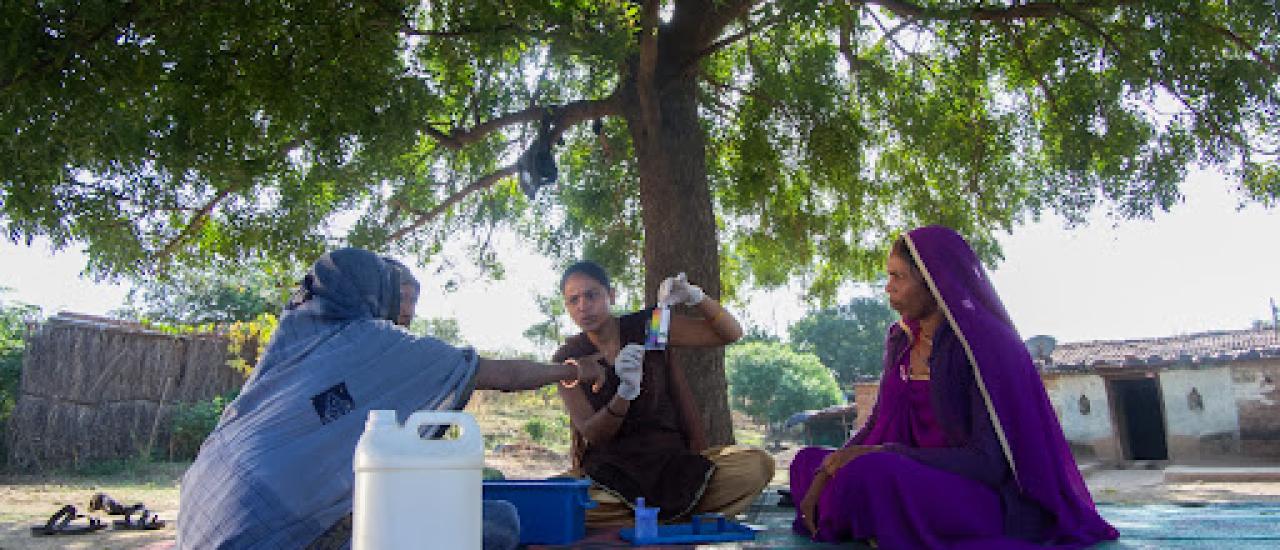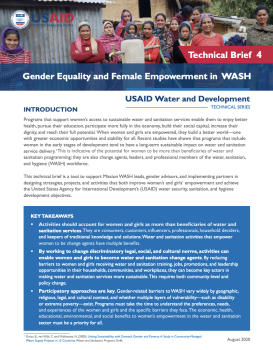GENDER EQUALITY AND FEMALE EMPOWERMENT
Context
Water insecurity, including lack of access to drinking water, sanitation, and hygiene products and services, disproportionately impacts women and girls. Globally, women and girls spend 200 million hours every day collecting water. This responsibility contributes to significant time poverty among many of the world’s poorest women and girls, preventing them from going to work or school, from starting or growing businesses, and from engaging in social activities. Traveling long distances to collect water also increases women and girls’ risk to gender-based violence. Lack of access to water and sanitation services, coupled with insufficient access to menstrual hygiene products and a lack of social support, can lead to women and girls missing up to 20% of school days and potentially dropping out. Women are estimated to make up less than 20 percent of employees at water utilities, while approximately 25 countries have legal prohibitions on women working in the water sector and at least a dozen prohibit women from working in sewers. Furthermore, women are under-represented in household, community, and political decision-making, including as water resource managers, despite evidence showing that when women join men in shaping water policies, communities benefit more and the impacts are more sustainable.
LGBTQI+ individuals using shared, public, or communal latrines risk violence, humiliation, exclusion, a denial of access to a basic service, and even arrest; these risks are especially acute for transgender or third gender individuals. Those with diverse gender identity and gender expression may be denied access to water and sanitation services due to a lack of legal identity papers that reflect lived gender.

Photo Credit: Vaishnavi Suresh, Gap Inc.
USAID’s Approach
Programs that support women’s access to sustainable water and sanitation services enable them to enjoy better health, pursue an education, participate more fully in the economy, build their social capital, increase their dignity, and reach their full potential. USAID works to reach women and girls with access to water and sanitation services, and menstrual health and hygiene information, services and supplies. USAID also works to promote their participation in water-related decision-making, access to water and sanitation jobs, and financing for small, women-owned water and sanitation businesses and household service upgrades.
USAID seeks to ensure that women are empowered to effectively advocate for their perspectives and priorities, and that they are able to fully engage as managers, partners, and entrepreneurs in water-related activities and enterprises. USAID takes an intersectional approach, recognizing that women, girls, and members of the LGBTQI+ community may have overlapping experiences that make them less likely to fully benefit from water resources management, allocation, and basic water and sanitation services. These include income and education level, social status, geography, ethnicity and religion, disability, and age.
To increase gender equitable access to safe and sustainable water and sanitation services, and equitable management of water resources, USAID works with its partners to:
- Address gaps and mitigate barriers to women’s equality in national and local government water and sanitation policies, including water tenure
- Support female water and sanitation entrepreneurs to secure the financing they need
- Promote on-premises drinking water and female-friendly, area-wide, safe and sustainable sanitation that decreases the distance to points of access
- Promote menstrual health and hygiene, including by enhancing menstruation education and supporting MHH-friendly policies and supply chains
- Support water service providers and basin organizations to be more inclusive and enable women to enter these professions and take on leadership positions
Read more in the U.S. Global Water Strategy.
Related Policies and Strategies
Related Resources
- Transforming the role of women from water carriers to water ATM entrepreneurs: Poonam Sewak, Safe Water Network
- H2O Maghreb Empowers Moroccan Women to Play New Roles in Sustainable Water Management
- Women + Water Alliance Video Library
- When Women Manage Water
- Inclusive Development in India: USAID Partners with Local Transgender Community on WASH





